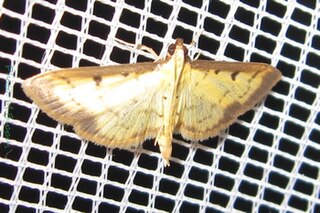
The Crambidae are the grass moth family of lepidopterans. They are variable in appearance, the nominal subfamily Crambinae taking up closely folded postures on grass stems where they are inconspicuous, while other subfamilies include brightly coloured and patterned insects which rest in wing-spread attitudes.

Pyraustinae is a large subfamily of the lepidopteran family Crambidae, the crambid snout moths. It currently includes over 1,400 species; most of them tropical but some found in temperate regions including both North America and Europe.
Anarmodia is a genus of moths of the family Crambidae.

Udea is a genus of snout moths in the subfamily Spilomelinae of the family Crambidae. The genus was erected by Achille Guenée in 1845. The currently known 215 species are present on all continents except Antarctica. About 41 species are native to Hawaii.

Pyrausta is a speciose genus of moths of the family Crambidae. The genus was erected by Franz von Paula Schrank in 1802.

Pyrausta pastrinalis is a moth of the family Crambidae. The species was described by Achille Guenée in 1862. It is endemic to Réunion, where it is common at low and medium altitudes.

Glaphyriinae is a subfamily of the lepidopteran family Crambidae. It was described by William Trowbridge Merrifield Forbes in 1923. The subfamily currently comprises 509 species in 75 genera.

Pyrausta bicoloralis, the bicolored pyrausta moth, is a moth in the family Crambidae. It was described by Achille Guenée in 1854. It is found in North America, where it has been recorded from Nova Scotia south to Florida, west to Michigan and Texas. In the south, the range extends to South America.
Pyrausta cardinalis is a moth in the family Crambidae. It was described by Achille Guenée in 1854. It is found in Florida, Cuba, the Dominican Republic and on the Virgin Islands and Puerto Rico.
Pyrausta approximalis is a moth in the family Crambidae. It was described by Achille Guenée in 1854. It is found in Sierra Leone.

Pyrausta insignitalis, the dark-banded pyrausta moth, is a moth in the family Crambidae. It was described by Achille Guenée in 1854. It is found in the United States, where it has been recorded from Florida and South Carolina. It is also found on the West Indies, as well as in Central and South America.
Pyrausta silhetalis is a moth in the family Crambidae. It was described by Achille Guenée in 1854. It is found in Bangladesh, India and Kashmir.
Pyrausta subinquinalis is a moth in the family Crambidae. It was described by Achille Guenée in 1854. It is found in Brazil.

Pyrausta subsequalis, also known as the weedfield sable, is a moth in the family Crambidae. It was described by Achille Guenée in 1854. It is found in much of North America, where it has been recorded from southern Alberta and southern British Columbia south to Arizona and New Mexico and east to Florida and north to Ontario. The habitat consists of dry prairie areas.

Pyrausta tyralis, the coffee-loving pyrausta moth, is a moth in the family Crambidae. It was described by Achille Guenée in 1854. It is found in the United States, where it has been recorded from New York to Illinois and from Florida to Arizona. It is also found from Mexico to Venezuela, as well as on the West Indies.










